Authentication (User Registration B - Customized Form) on Shared Host using FastCGI

As a continuation from the previous chapter, User Registration on Shared Host using FastCGI. in this chapter, we will extend user registration. It will include email data and it's a customized version of UserCreationForm.
As in the previous chapters, we need keep two files in ~/www/dj directory:
# pwd /home2/bogotob1/public_html/dj # ls ./ ../ djangoproject.fcgi* .htaccess
djangoproject.fcgi:
#! /home2/bogotob1/python/bin/python import sys, os sys.path.insert(0, "/home2/bogotob1/python") sys.path.insert(13, "/home2/bogotob1/djangoproject") os.environ['DJANGO_SETTINGS_MODULE'] = 'djangoproject.settings' from django.core.servers.fastcgi import runfastcgi runfastcgi(method="threaded", daemonize="false")
where /home2/bogotob1/ is my home(~) directory.
.htaccess:
# django
AddHandler fcgid-script .fcgi
RewriteEngine On
RewriteCond %{REQUEST_FILENAME} !-f
RewriteRule ^(.*)$ djangoproject.fcgi/$1 [QSA,L]
Similar to the urls, we're going to add new views for registration to views.py. We'll also make a customized form (forms.py) by extending the UserCreationForm imported from django.contrib.auth.forms.
from django import forms
from django.contrib.auth.models import User
from django.contrib.auth.forms import UserCreationForm
class MyRegistrationForm(UserCreationForm):
email = forms.EmailField(required = True)
class Meta:
model = User
fields = ('username', 'email', 'password1', 'password2')
def save(self, commit = True):
user = super(UserCreationForm, self).save(commit = False)
user.email = self.cleaned_data['email']
if commit:
user.save()
return user
Now that we have a customized form, we're going to use that form for registration. Here is a new views.py:
from django.shortcuts import render_to_response
from django.http import HttpResponseRedirect
from django.contrib import auth
from django.core.context_processors import csrf
from forms import MyRegistrationForm
def home(request):
return render_to_response('home.html',
{'Testing' : 'Django Template Inheritance ',
'HelloHello' : 'Hello World - Django'})
def login(request):
c = {}
c.update(csrf(request))
return render_to_response('login.html', c)
def auth_view(request):
username = request.POST.get('username', '')
password = request.POST.get('password', '')
user = auth.authenticate(username=username, password=password)
if user is not None:
auth.login(request, user)
return HttpResponseRedirect('/dj/accounts/loggedin')
else:
return HttpResponseRedirect('/dj/accounts/invalid')
def logout(request):
auth.logout(request)
return render_to_response('logout.html')
def loggedin(request):
return render_to_response('loggedin.html',
{'full_name': request.user.username})
def invalid_login(request):
return render_to_response('invalid_login.html')
def register_user(request):
# 2nd time around
if request.method == 'POST':
form = MyRegistrationForm(request.POST)
if form.is_valid():
form.save()
return HttpResponseRedirect('/dj/accounts/register_success')
# 1st time visit
args = {}
args.update(csrf(request))
# form with no input
args['form'] = MyRegistrationForm()
print args
return render_to_response('register.html', args)
def register_success(request):
return render_to_response('register_success.html')
The same urls.py we used before:
from django.conf.urls import patterns, include, url
from django.contrib import admin
admin.autodiscover()
urlpatterns = patterns('',
# Examples:
url(r'^$', 'djangoapp.views.home', name='home'),
# url(r'^blog/', include('blog.urls')),
url(r'^admin/', include(admin.site.urls)),
# user authentication urls
url(r'^accounts/login/$', 'djangoapp.views.login'),
url(r'^accounts/auth/$', 'djangoapp.views.auth_view'),
url(r'^accounts/login/accounts/auth/$', 'djangoapp.views.auth_view'),
url(r'^accounts/logout/$', 'djangoapp.views.logout'),
url(r'^accounts/loggedin/$', 'djangoapp.views.loggedin'),
url(r'^accounts/invalid/$', 'djangoapp.views.invalid_login'),
url(r'^accounts/register/$', 'djangoapp.views.register_user'),
url(r'^accounts/register_success/$', 'djangoapp.views.register_success'),
)
Here is the tree view of the files:

Let's register with username as register_test2:
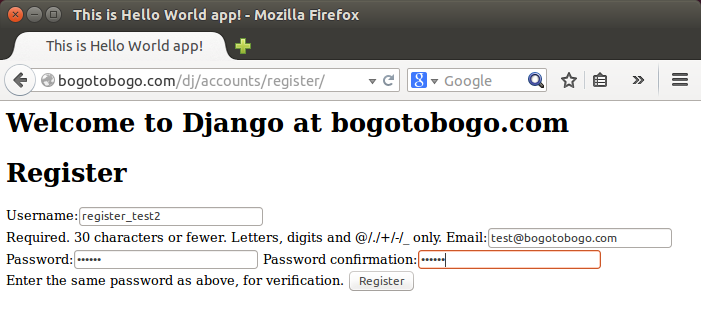
If the registration is successful, we get the following page:
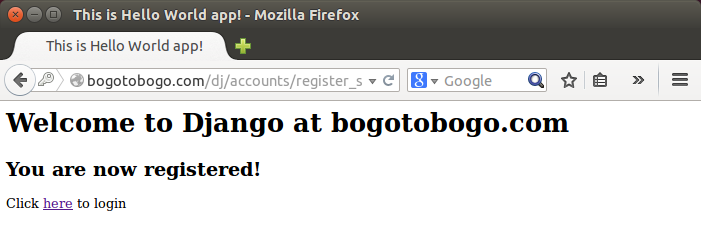
We can check if the user (register_test) is there from admin page:

To add first and last names for user registration is straight forward. We just modify the forms.py:
from django import forms
from django.contrib.auth.models import User
from django.contrib.auth.forms import UserCreationForm
class MyRegistrationForm(UserCreationForm):
email = forms.EmailField(required = True)
first_name = forms.CharField(required = True)
last_name = forms.CharField(required = True)
class Meta:
model = User
fields = ('last_name', 'first_name', 'username', 'email', 'password1', 'password2')
def save(self, commit = True):
user = super(UserCreationForm, self).save(commit = False)
user.email = self.cleaned_data['email']
user.first_name = self.cleaned_data['first_name']
user.last_name = self.cleaned_data['last_name']
if commit:
user.save()
return user
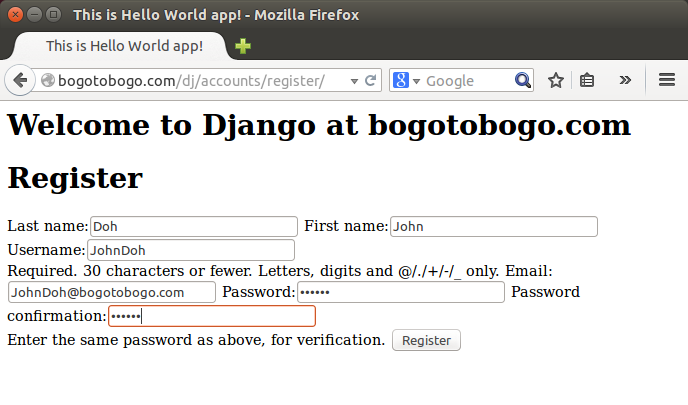
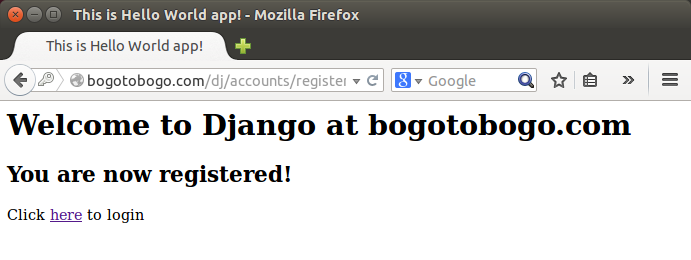
We can check MySQL database if the user is registered via phpMyAdmin in addition to the DjangoAdmin:
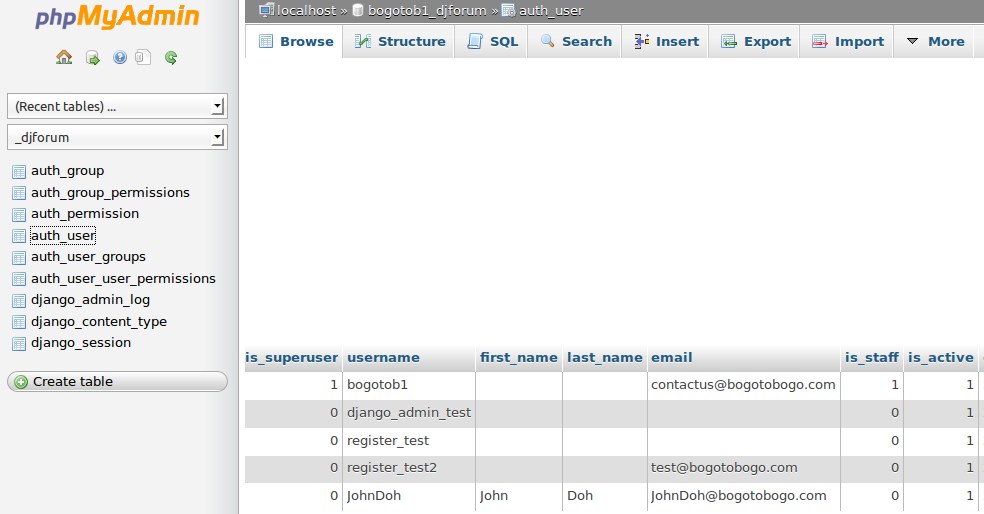
Ph.D. / Golden Gate Ave, San Francisco / Seoul National Univ / Carnegie Mellon / UC Berkeley / DevOps / Deep Learning / Visualization